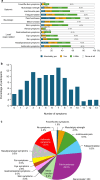Reality of Patient-Reported Symptoms in 200 Patients with Eosinophilic Granulomatosis with Polyangiitis: A Cross-Sectional Survey (The KUNPU Study)
- PMID: 40392509
- PMCID: PMC12182462
- DOI: 10.1007/s12325-025-03197-5
Reality of Patient-Reported Symptoms in 200 Patients with Eosinophilic Granulomatosis with Polyangiitis: A Cross-Sectional Survey (The KUNPU Study)
Abstract
Introduction: Eosinophilic granulomatosis with polyangiitis (EGPA) is a type of antineutrophil cytoplasmic antibody-associated vasculitis characterized by inflammation of small- and medium-sized vessels, causing symptoms in multiple organs. The symptoms and daily life problems reported by patients with EGPA themselves are largely unknown. We conducted a cross-sectional survey to investigate the reality of EGPA-related symptoms in patients with EGPA.
Methods: Specialists and specialized facilities with experience in treating patients with EGPA cooperated in the survey; specialists from 28 facilities across Japan participated. Patients diagnosed with EGPA by their physician and treated for ≥ 1 year who agreed to answer the online questions were enrolled and completed the survey between March and June 2024. Patients answered questions about their general symptoms, asthma symptoms, and quality of life.
Results: We analyzed valid responses from 200 patients (61.0% female/38.5% male/0.5% prefer not to answer) with EGPA. The mean age was 57.9 years and 34.5% were ≥ 65 years old. Patients were treated at rheumatology departments (48.0%), respiratory/allergy departments (48.0%), and other departments (4.0%). Basic treatments included oral glucocorticoids (63.0%) and anti-interleukin-5/receptor α biologics (61.0%). Symptoms in > 50.0% of patients (past month) were pain/numbness (73.5%), fatigue/malaise (68.0%), asthmatic symptoms (56.0%), nasal/paranasal symptoms (55.0%), and joint/muscle pain (54.5%). Pain/numbness was considered the most painful symptom (29.5%). Nearly all patients experienced symptoms affecting two or more organs/systems. Patients reported that EGPA symptoms had detrimental impacts on physical and mental health; 67.0% of patients thought they were not understood by others because their disease is invisible, and symptoms frequently affected their daily life (61.5%), work (53.0%), sleep (49.5%), and social life (36.5%).
Conclusion: This is the largest survey of patients with EGPA. We have revealed the reality of patients' perceptions of EGPA-related symptoms. These results are expected to contribute to improvement in patient-centered EGPA management.
Trial registration: jRCT1050230186.
Keywords: EGPA; Eosinophilic granulomatosis with polyangiitis; Patient-reported outcomes; Quality of life.
© 2025. The Author(s).
Conflict of interest statement
Declarations. Conflict of Interest: Koichi Amano has received honoraria from AbbVie, AstraZeneca, Chugai Pharmaceutical, Eisai, Eli Lilly, GSK, and Pfizer. Keita Ono, Kazuya Sumi, Hitomi Uchimura, Hayato Oka, and Naoyuki Makita are employees of AstraZeneca K.K. Masami Taniguchi has received grants from GSK and honoraria from AstraZeneca, GSK, and Sanofi. Ethical Approval: This study was conducted in adherence to the Declaration of Helsinki, Ethical Guidelines for Medical and Biological Research Involving Human Subjects, and Japanese laws and regulations. The KUNPU study was approved by the Takahashi Pediatric Clinic Institutional Review Board (approval number LNW00196, January 2024) and registered at jRCT (jRCT1050230186). All participants gave electronic informed consent prior to registration in the KUNPU study, and medical data were collected and stored in compliance with the relevant laws/regulations concerning data protection and the Personal Information Protection Act.
Figures



Similar articles
-
Comparison of Imaging Findings between Granulomatosis with Polyangiitis and Eosinophilic Granulomatosis with Polyangiitis on Sinus CT: Importance of High-Density Opacification of the Paranasal Sinuses.AJNR Am J Neuroradiol. 2025 Feb 3;46(2):355-361. doi: 10.3174/ajnr.A8485. AJNR Am J Neuroradiol. 2025. PMID: 39824628
-
Burden of illness associated with eosinophilic granulomatosis with polyangiitis: a systematic literature review and meta-analysis.Clin Rheumatol. 2021 Dec;40(12):4829-4836. doi: 10.1007/s10067-021-05783-8. Epub 2021 Jun 23. Clin Rheumatol. 2021. PMID: 34159493 Free PMC article.
-
Mepolizumab efficacy and safety in patients with eosinophilic granulomatosis with polyangiitis in real practice: Data from a Spanish retrospective multicentric register from Rheumatology departments.Reumatol Clin (Engl Ed). 2025 Jan;21(1):101806. doi: 10.1016/j.reumae.2025.101806. Reumatol Clin (Engl Ed). 2025. PMID: 39894626
-
Dupilumab-induced Eosinophilic Granulomatosis with Polyangiitis Complicated by Peripheral Neuropathic Pain: a Case Report and Literature Review.J Clin Immunol. 2025 Jul 24;45(1):114. doi: 10.1007/s10875-025-01914-x. J Clin Immunol. 2025. PMID: 40705100 Free PMC article. Review.
-
MPO-ANCA-positive eosinophilic granulomatosis with polyangiitis complicated by alveolar haemorrhage treated with mepolizumab as an induction therapy: Case report.Mod Rheumatol Case Rep. 2025 Jul 25;9(2):rxae088. doi: 10.1093/mrcr/rxae088. Mod Rheumatol Case Rep. 2025. PMID: 39707621
References
-
- Grayson PC, Ponte C, Suppiah R, et al. 2022 American College of Rheumatology/European Alliance of Associations for Rheumatology classification criteria for eosinophilic granulomatosis with polyangiitis. Ann Rheum Dis. 2022;81(3):309–14. 10.1136/annrheumdis-2021-221794. - PubMed
-
- Furuta S, Iwamoto T, Nakajima H. Update on eosinophilic granulomatosis with polyangiitis. Allergol Int. 2019;68(4):430–6. 10.1016/j.alit.2019.06.004. - PubMed
-
- Jennette JC, Falk RJ, Bacon PA, et al. 2012 revised international Chapel Hill consensus conference nomenclature of vasculitides. Arthritis Rheum. 2013;65(1):1–11. 10.1002/art.37715. - PubMed
-
- Cottin V, Bel E, Bottero P, et al. Respiratory manifestations of eosinophilic granulomatosis with polyangiitis (Churg-Strauss). Eur Respir J. 2016;48(5):1429–41. 10.1183/13993003.00097-2016. - PubMed
-
- Hellmich B, Sanchez-Alamo B, Schirmer JH, et al. EULAR recommendations for the management of ANCA-associated vasculitis: 2022 update. Ann Rheum Dis. 2024;83(1):30–47. 10.1136/ard-2022-223764. - PubMed
Publication types
MeSH terms
LinkOut - more resources
Full Text Sources
Medical
Molecular Biology Databases
Miscellaneous

